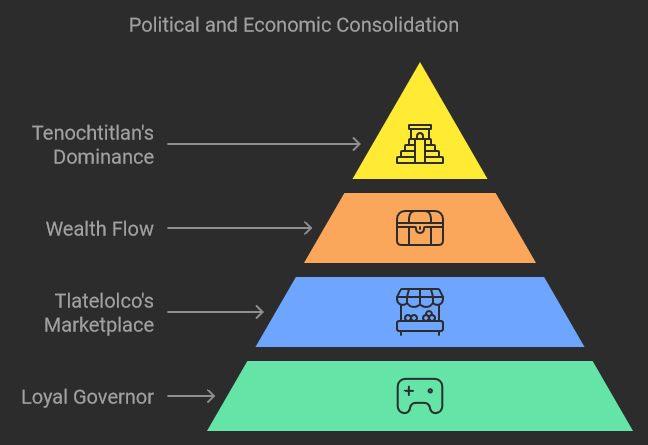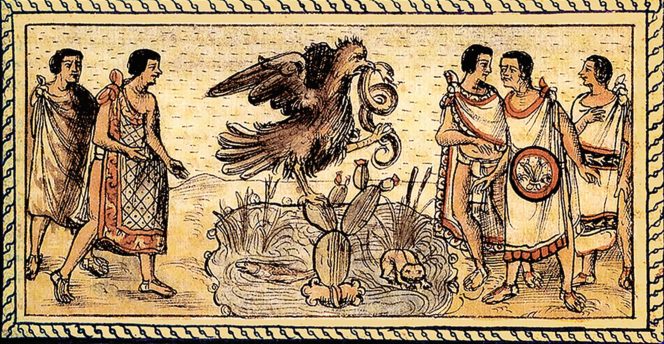Axayacatl was the sixth emperor of the Aztec Empire, ruling from 1469 to 1481. His reign is notable for several significant military, political, and architectural accomplishments. As a key figure in the early expansion of the empire, Axayacatl was known for his military prowess, strategic conquests, and consolidation of political power. His reign is marked by significant military campaigns, both victorious and unsuccessful, which influenced the geographic and political landscape of Mesoamerica. Alongside his military achievements, Axayacatl also undertook critical internal developments, including expanding Tenochtitlan’s religious structures and managing its complex tribute system. His leadership not only solidified the dominance of the Aztecs but also laid the groundwork for the continued expansion of the empire under his successors.
Throughout his reign, Axayacatl faced a series of challenges, including a major defeat against the Tarascan Empire, which placed a limit on Aztec territorial ambitions. Nevertheless, his victories, particularly the conquest of Tlatelolco, helped unify the region and strengthen the economic and political power of Tenochtitlan. The legacy of his leadership continues to be an important chapter in Aztec history, illustrating both the empire’s growth and its limitations during a crucial period of development.
1. Military Conquests
Conquest of Tlatelolco (1473)
Tlatelolco was a neighboring city-state that shared the island of Lake Texcoco with Tenochtitlan. Although originally allied, Tlatelolco began to assert its independence under its ruler, Moquihuix. Tensions rose as Moquihuix attempted to break away from Aztec control. In response, Axayacatl launched a decisive military campaign in 1473, successfully defeating the Tlatelolcan forces and killing Moquihuix. This victory was significant for several reasons. First, it allowed Tenochtitlan to consolidate control over Tlatelolco, which housed an important marketplace crucial for trade in the region. Second, it marked the unification of the entire island under Axayacatl’s rule, further strengthening the political dominance of Tenochtitlan over its neighbors.
Campaigns Against Neighboring City-States
Beyond Tlatelolco, Axayacatl led several other successful military campaigns, most notably against the Matlatzincas, a group that lived in the Toluca Valley. This conquest was strategically important as it secured Aztec control over a vital region in central Mexico, expanding the empire’s influence and strengthening its economic base. Axayacatl’s expansionist efforts in the surrounding areas further cemented his reputation as a formidable military leader and helped to increase the resources and territories under Aztec control.
Defeat Against the Tarascans (1479)
Despite his many successes, Axayacatl also faced significant challenges. In 1479, he led a military campaign against the Tarascan Empire, located in Michoacán, one of the few Mesoamerican civilizations able to resist Aztec expansion. This campaign resulted in a devastating defeat for Axayacatl’s forces, halting Aztec expansion into the western territories. The loss against the Tarascans dealt a severe blow to Axayacatl’s military reputation and marked a rare failure in the otherwise aggressive expansion of the Aztec Empire. This defeat underscored the limits of Aztec imperialism and highlighted the strength of the Tarascan Empire as a regional power.

2. Internal Developments and Political Consolidation
Tenochtitlan and Tlatelolco Relations
Following the conquest of Tlatelolco in 1473, Axayacatl’s primary focus was on political consolidation within the region. To solidify his control over the recently subjugated city-state, Axayacatl installed a loyal governor in Tlatelolco who was responsible for managing the city under Tenochtitlan’s dominance. The importance of controlling Tlatelolco extended beyond politics; the city housed a crucial regional trade hub, with its bustling marketplace acting as a key economic engine for the area. By asserting control over this market, Axayacatl ensured the flow of wealth and resources into Tenochtitlan, further strengthening its economic position and allowing the Aztec capital to maintain its dominance over the region.
Reconstruction of the Templo Mayor
One of Axayacatl’s most significant internal developments was the reconstruction and expansion of the Templo Mayor, the grand temple complex at the heart of Tenochtitlan. The Templo Mayor held immense religious and political significance for the Aztec people, being dedicated to two of their principal deities: Huitzilopochtli, the god of war, and Tlaloc, the god of rain and fertility. Under Axayacatl’s rule, the temple was expanded to reflect the growing power and influence of the empire. This architectural project not only showcased the wealth and prestige of the Aztecs but also emphasized the importance of religious practices, including human sacrifices, in maintaining cosmic order and ensuring the prosperity of the empire. Axayacatl’s role in expanding the Templo Mayor was a direct statement of the empire’s increasing dominance, both spiritually and politically.

3. Economic and Cultural Impact
Tribute System
As Axayacatl expanded the empire through his conquests, the Aztec tribute system grew increasingly vital to sustaining the wealth and power of Tenochtitlan. City-states that were brought under Aztec control were required to pay tribute, often in the form of goods such as food, textiles, precious metals, and slaves. This tribute system was crucial for the empire’s economy, enriching Tenochtitlan and providing the resources needed to fund its military campaigns and monumental architectural projects, such as the expansion of the Templo Mayor. The influx of resources allowed the Aztec capital to flourish and reinforced the centralization of power within the empire, with Axayacatl playing a key role in maintaining and expanding this system of economic dominance.
Political Alliances and Diplomacy
In addition to military conquests, Axayacatl was skilled in diplomacy, maintaining and strengthening political alliances, particularly the Triple Alliance between Tenochtitlan, Texcoco, and Tlacopan. This alliance was crucial for the Aztecs’ ability to project power across central Mexico. By working cooperatively with these allied city-states, Axayacatl ensured the stability and longevity of the Aztec Empire’s influence. Additionally, Axayacatl strategically used marriages and other diplomatic measures to cement the empire’s dominance, ensuring that the Aztecs remained the foremost political and military power in the region. This blend of military might and political diplomacy was central to Axayacatl’s ability to maintain control and expand Aztec hegemony.
4. Axayacatl’s Legacy
Consolidation of Power
Axayacatl’s military victories, particularly the conquest of Tlatelolco in 1473, were crucial in laying the foundation for the continued expansion and consolidation of the Aztec Empire. By bringing Tlatelolco under the direct control of Tenochtitlan, Axayacatl unified the island and solidified Tenochtitlan’s political dominance over its neighbors. The integration of Tlatelolco’s marketplace not only enriched the empire but also strengthened its political and economic control over the region, creating a platform for future rulers to build upon. Axayacatl’s ability to blend military conquests with strategic political consolidation helped establish a centralized and stable empire, one that would continue to expand and flourish under his successors.
Long-Term Impact on the Aztec Empire
Axayacatl’s legacy extended beyond his reign, shaping the future trajectory of the Aztec Empire. His brother and successor, Tizoc, inherited the empire that Axayacatl had fortified, though Tizoc’s rule was far less successful in terms of military conquests. Nevertheless, the foundation laid by Axayacatl, particularly through his unification of Tenochtitlan and his successful campaigns, ensured the Aztec Empire remained a dominant force in central Mexico. His military conquests, political alliances, and contributions to religious and economic structures played an enduring role in the empire’s resilience and expansion well into the reigns of his successors. Axayacatl’s achievements continued to influence the direction of the empire, providing a model of leadership that balanced military might with political consolidation and religious dedication.
Conclusion
Axayacatl’s reign from 1469 to 1481 was a defining period in Aztec history. His military successes, particularly the conquest of Tlatelolco, allowed for the consolidation of power within Tenochtitlan and the expansion of the empire’s influence across central Mexico. His political consolidation efforts, including the installation of loyal governors and the expansion of the tribute system, created a more unified and prosperous Aztec state. Additionally, his reconstruction of the Templo Mayor and the strengthening of diplomatic alliances reinforced the religious, political, and economic foundations of the empire.
Understanding Axayacatl’s reign provides valuable insight into the broader history of the Aztec Empire and its role in Mesoamerican civilization. His contributions not only shaped the future trajectory of the empire but also illustrated the complexity of Aztec governance, military strategy, and religious life. Axayacatl’s legacy as a military leader, political consolidator, and builder of the empire is a testament to his significant role in shaping the Aztec world.
References
- Smith, Michael E. The Aztecs. 2nd ed. Oxford: Blackwell Publishers, 2003.
- Townsend, Richard F. The Aztecs. Revised Edition. London: Thames & Hudson, 2009.
- Hassig, Ross. Aztec Warfare: Imperial Expansion and Political Control. Norman: University of Oklahoma Press, 1995.
